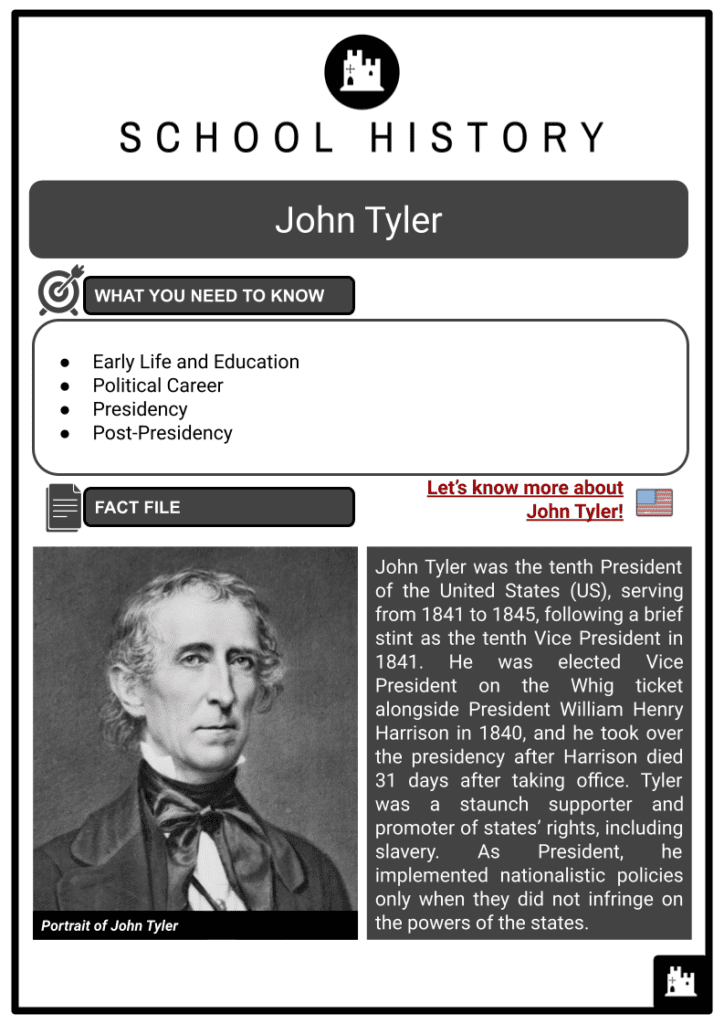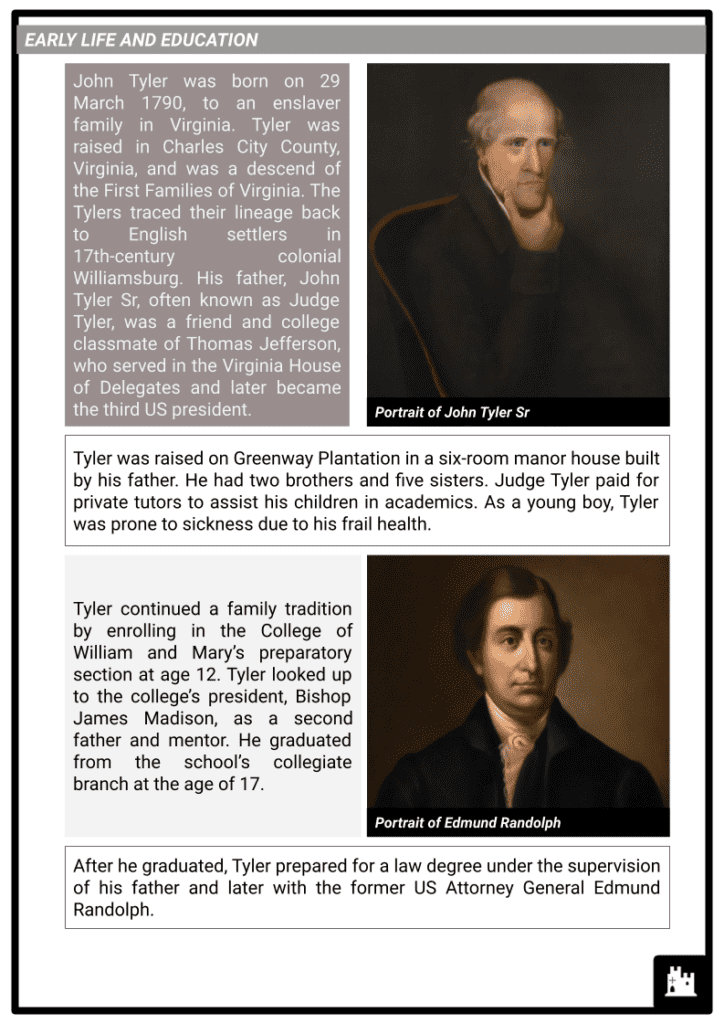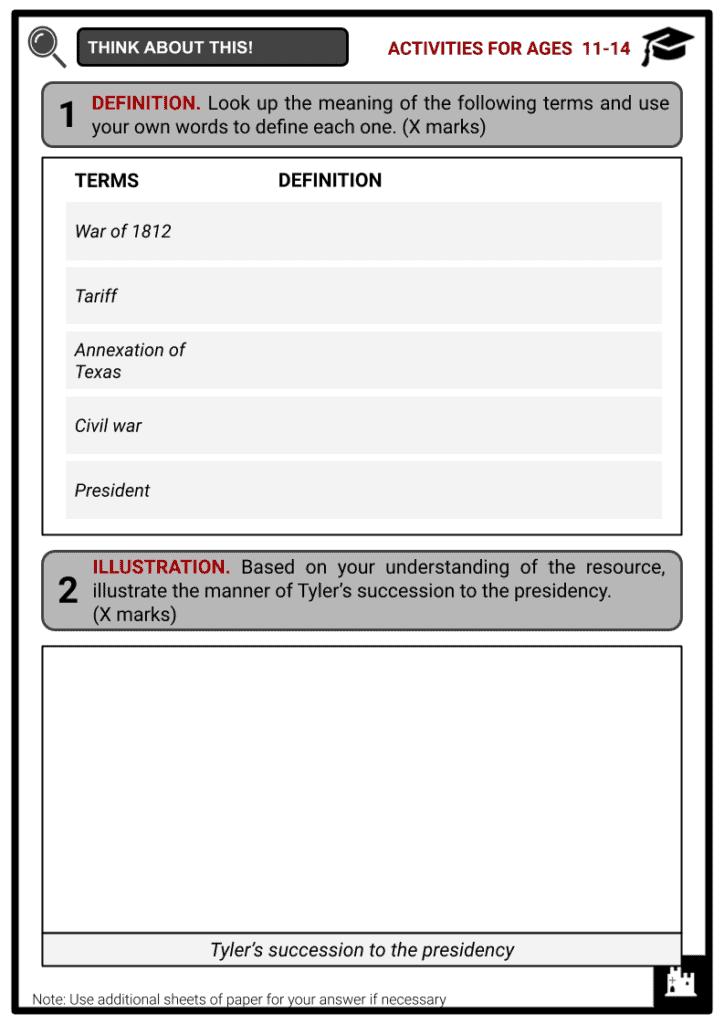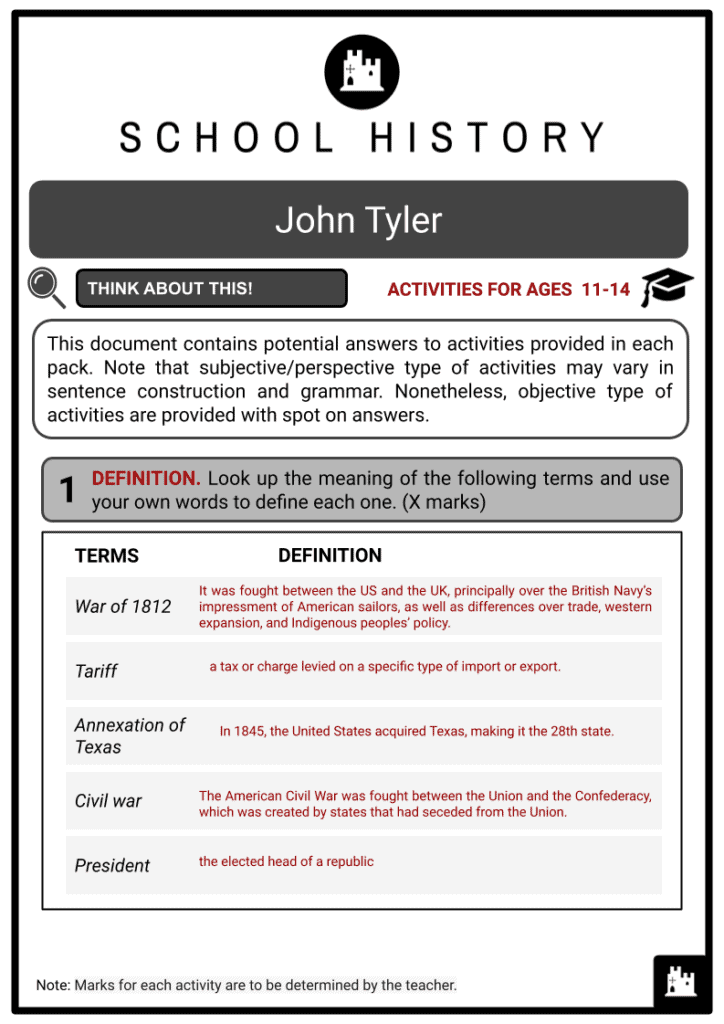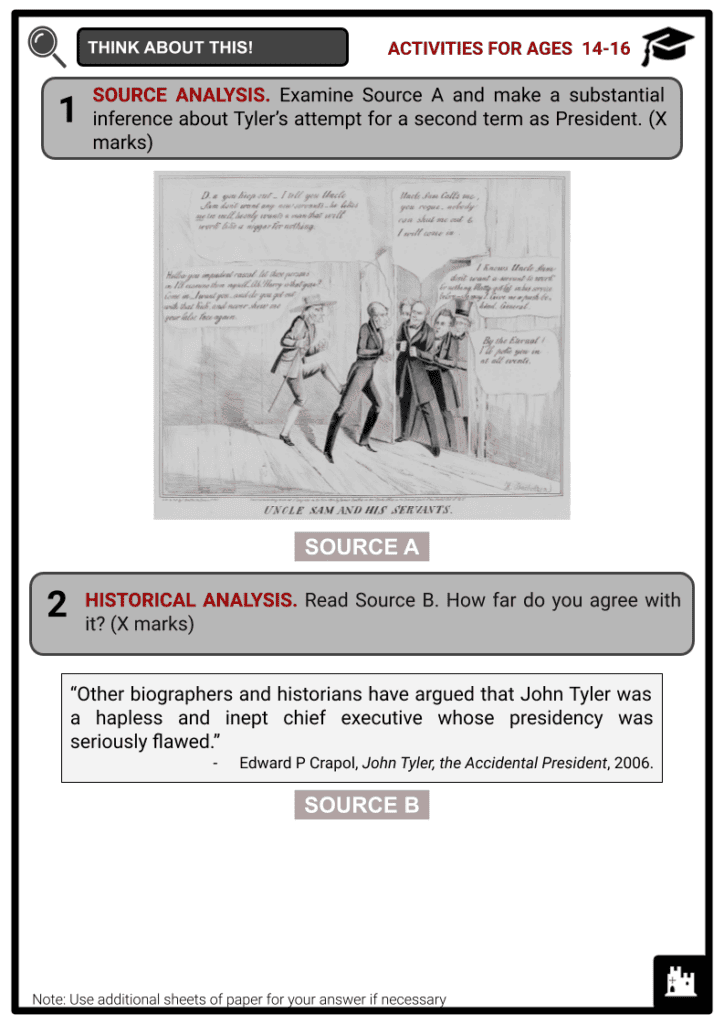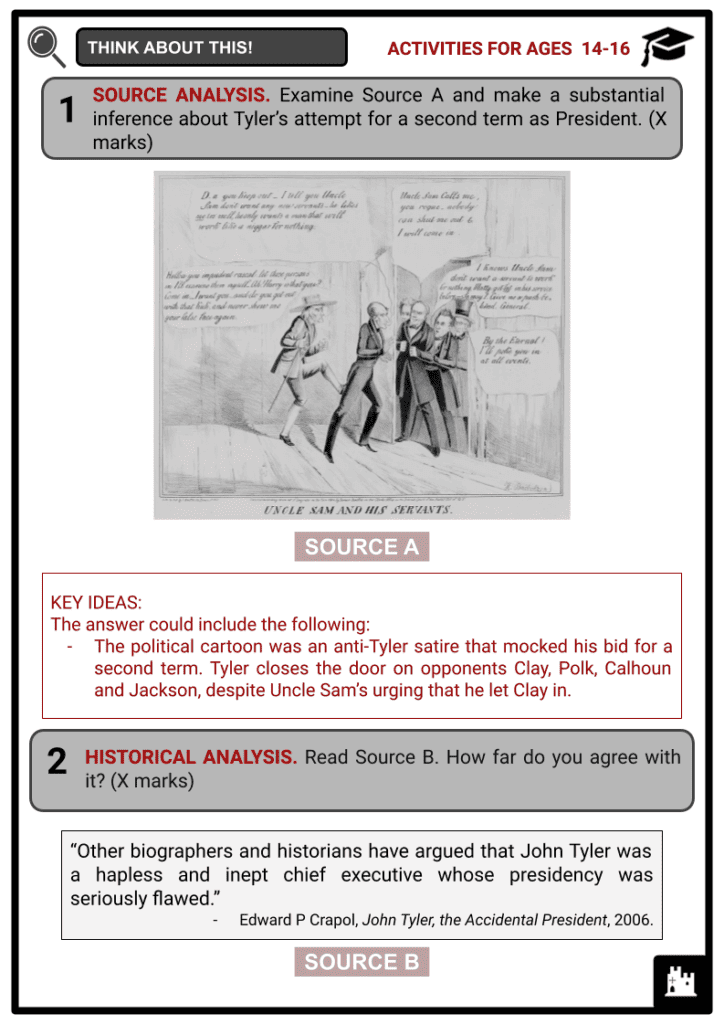John Tyler Worksheets
Do you want to save dozens of hours in time? Get your evenings and weekends back? Be able to teach about John Tyler to your students?
Our worksheet bundle includes a fact file and printable worksheets and student activities. Perfect for both the classroom and homeschooling!
Summary
- Early Life and Education
- Political Career
- Presidency
- Post-Presidency
Key Facts And Information
Let’s know more about John Tyler!
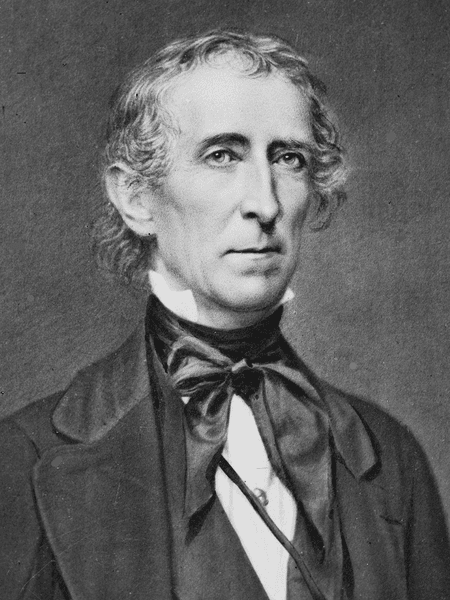
John Tyler was the tenth President of the United States (US), serving from 1841 to 1845, following a brief stint as the tenth Vice President in 1841. He was elected Vice President on the Whig ticket alongside President William Henry Harrison in 1840, and he took over the presidency after Harrison died 31 days after taking office. Tyler was a staunch supporter and promoter of states’ rights, including slavery. As President, he implemented nationalistic policies only when they did not infringe on the powers of the states.
EARLY LIFE AND EDUCATION
- John Tyler was born on 29 March 1790, to an enslaver family in Virginia. Tyler was raised in Charles City County, Virginia, and was a descend of the First Families of Virginia. The Tylers traced their lineage back to English settlers in 17th-century colonial Williamsburg. His father, John Tyler Sr, often known as Judge Tyler, was a friend and college classmate of Thomas Jefferson, who served in the Virginia House of Delegates and later became the third US president.
- Tyler was raised on Greenway Plantation in a six-room manor house built by his father. He had two brothers and five sisters. Judge Tyler paid for private tutors to assist his children in academics. As a young boy, Tyler was prone to sickness due to his frail health.
- Tyler continued a family tradition by enrolling in the College of William and Mary’s preparatory section at age 12. Tyler looked up to the college’s president, Bishop James Madison, as a second father and mentor. He graduated from the school’s collegiate branch at the age of 17.
- After he graduated, Tyler prepared for a law degree under the supervision of his father and later with the former US Attorney General Edmund Randolph.
- Tyler was admitted to the Virginia bar when he was 19 years old. By this time, his father was the governor of Virginia, and Tyler began his legal career in Richmond. It was known in the federal census released in 1810 that the Tyler family had eight enslaved people in Richmond, five enslaved people in neighbouring Henrico County, and possibly 26 enslaved people in Charles City County.
POLITICAL CAREER
- At 21, Tyler was elected to represent Charles City County in the House of Delegates in 1811. He served five one-year terms, the first with Cornelius Egmon and later with Benjamin Harrison. Tyler served on the Courts and Justice Committee as a state representative. By the end of his first term in 1811, he had established himself as a staunch supporter of state sovereignty and an opponent of a national bank.
- Tyler joined fellow legislator Benjamin W Leigh in condemning Virginia senators William Branch Giles and Richard Brent for voting for the recharter of the First Bank of the United States against the wishes of the Virginia legislature.
- The War of 1812 was fought in British North America by the US and its Indigenous allies against the United Kingdom (UK) and its Indigenous allies, with participation by Spain in Florida. Tensions arose from long-standing disagreements about North American territorial expansion and British support for Indigenous nations who opposed US colonisation in the Old Northwest.
- Like most Americans during the War of 1812, Tyler was anti-British, and in an address to the House of Delegates at the start of the war, he urged support for military action. In 1813, after the British invaded Hampton, Virginia, Tyler established a militia company called the Charles City Rifles. Tyler led the militia as the captain to defend Richmond. He terminated the company two months later because no attack occurred. Tyler obtained a property grant in Sioux City, Iowa, in exchange for his military service.
House of Representatives
- John Clapton, a US Representative, died in September 1816, which led to a vacancy in Virginia’s 23rd Congressional District. Together with his political ally, Andrew Stevenson, Tyler ran for said position.
- Tyler’s advantage over Stevenson was his political connections and campaign strategies, which led him to win the position. On 17 December 1816, Tyler was sworn into the Fourteenth Congress as a representative of the Democratic-Republican party. The Democratic-Republican Party was a political party in the US founded in the early 1790s by Thomas Jefferson and James Madison that advocated for republicanism, individual liberty, equal rights, decentralisation, free markets, free trade, and agrarianism.
- While the Democratic-Republicans had previously supported state rights, many members advocated for a stronger central government after the War of 1812.
- Most of Congress wanted the federal government to help fund internal upgrades like ports and highways. Tyler remained staunchly constructionist, rejecting such suggestions on constitutional and personal grounds.
- Tyler felt that each state should build vital projects within its borders with monies generated locally.
“...in so poor a condition as to require a charitable donation from Congress.”
- John Tyler as cited in John Tyler, Champion of the Old South, Oliver Perry Chitwood, 1964.
- Tyler was chosen as part of a five-person commission to audit the Second Bank of the United States in 1818 and was surprised by the corruption he discovered within the bank. With this, Tyler advocated for the bank’s charter to be revoked, but Congress rejected any such suggestion.
- Tyler also had a clash with General Andrew Jackson following Jackson’s 1818 invasion of Florida during the First Seminole War. The First Seminole War was a conflict between US armed troops and the Seminole peoples of Florida that lasted from 1817 to 1818 and resulted in Spain ceding Florida to the US.
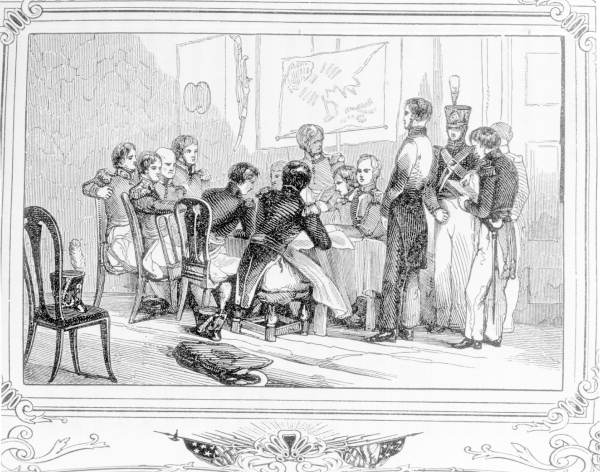
Portrait depicting ‘The trial of Ambrister during the Seminole War: Florida’ - Tyler praised Jackson’s character while condemning him for being overzealous in the killing of two British subjects. Jackson invaded Spanish Florida and caught and hanged two British men, Alexander George Arbuthnot and Robert C Ambrister, who were accused of assisting Seminole and Creek peoples against the US.
- Tyler declined to run for reelection in Virginia’s 23rd Congressional District in late 1820, claiming illness. He privately expressed displeasure with the post, observing that his opposing votes were primarily symbolic. He also noted that supporting his children’s college would be difficult on a congressman’s low income. On 3 March 1821, he resigned from office, supported his former opponent Stevenson for the seat, and returned to full-time private law practice.
- Tyler ran for the House of Delegates in 1823 after spending two years at home practising law. Because neither member from Charles City County was running for reelection, Tyler was easily elected in April, coming first out of three candidates for the two seats. Tyler’s political fortunes were growing:
- During the 1824 US legislative session, he was considered a probable candidate for the US Senate election.
- In December 1825, he was nominated for governor of Virginia, a position that was then filled by the legislature. Tyler defeated John Floyd with a vote of 131 to 81.
US Senate
- The General Assembly debated whether to elect a US president in January 1827. Senator John Randolph was re-elected to a full six-year term. Randolph was a divisive figure: while he shared the staunch states’ rights ideas of the majority of the Virginia legislature, he was known for his fiery language and erratic behaviour on the Senate floor, which left his supporters in an untenable position.
- The Democratic-Republican Party nationalists who supported John Quincy Adams and Kentucky Senator Henry Clay constituted a large minority in the Virginia legislature. They hoped to defeat Randolph by capturing the votes of states’ rights advocates dissatisfied with the senator’s record. They approached Tyler and pledged their support if he ran for the position. Tyler consistently rebuffed the offer, citing Randolph as the greatest choice, but political pressure grew. He eventually agreed to accept the seat if it was offered to him.
- Despite the rumours that there was no political difference between Tyler and Randolph, supporters of the incumbent candidate argued that Tyler’s election would be a tacit endorsement of the Adams government. Tyler was elected governor by a vote of 115 to 110, and he resigned on 4 March 1827, as his Senate term began.
- Tyler’s strained relationship with his party reached boiling point during the 22nd Congress when the nullification crisis of 1832–1833 erupted. South Carolina passed the Ordinance of Nullification in November 1832, threatening secession by declaring the Tariff of Abominations null and void inside its borders.
- The question of whether states might invalidate federal legislation arose due to the nullification crisis. Jackson, who denied such a right, was about to sign the Force Bill, which would authorise the federal government to impose the tariff with military force.
- Tyler, who sympathised with South Carolina’s arguments for nullification, opposed Jackson’s use of military force against a state and delivered a speech detailing his views in February 1833. Clay’s Compromise levy, imposed that year, progressively reduced the levy over ten years, relieving tensions between states and the federal government.
- Tyler was further insulted when Jackson moved to abolish the bank by executive order. Jackson issued an executive order in September 1833, asking Treasury Secretary Roger B Taney to transfer federal monies from the bank to state-chartered banks as soon as possible.
- As a symbolic gesture of approval, the Whigs voted Tyler President pro tempore of the Senate on 3 March 1835, with barely hours remaining in the congressional session. He is the only president of the US to have held this position.
- Tyler split with Jackson in the early 1830s over what he saw as an alarming expansion in federal power. Tyler joined the Whig Party and ran for vice president on a ticket with William Henry Harrison in 1840.
- After Harrison died in April 1841, Tyler became the first vice president to take office after the death of the president. His support for states’ rights collided with his party’s prevailing belief in a larger government, nearly forcing his administration to collapse.
PRESIDENCY
- Harrison’s death while in office was an uncommon occurrence that created significant concern about presidential succession. The US Constitution’s Article II, Section 1, Clause 6, which handled intra-term presidential succession at the time, states:
In Case of the Removal of the President from Office, or of his Death, Resignation, or Inability to discharge the Powers and Duties of the said Office, the Same shall devolve on the Vice President ....
- The interpretation of this constitutional provision raised whether Tyler held the actual office of President or only its powers and duties. Later on, Tyler became the US president at 51, and was the youngest president in history when he assumed office.
Economic policy
- Tyler initially agreed with the new Whig Congress, signing a preemption bill granting squatters’ sovereignty to settlers on public property, and a Distribution Act that enabled settlers to purchase 160-acre blocks of property in the West without having to compete in an auction. However, regarding the major banking question, Tyler quickly disagreed with the Congressional Whigs and rejected Clay’s measure for a national banking act twice.
Tariff and distribution debate
- By mid-1841, the federal government faced a $11 million fiscal shortfall. Tyler recognised the necessity for increasing tariffs but preferred to remain within the 20% rate established by the 1833 Compromise Tariff. He also backed a plan to give any cash from the sale of public land to the states as an emergency solution to control the states’ mounting debt, even though this would reduce federal revenue. It was enacted during Jackson’s presidency in response to Southerners’ complaints about the protectionism found in the Tariff of 1832 and the Tariff of Abominations. The taxes had spurred South Carolina to threaten secession from the Union.
- In May 1841, Tyler appointed three private people to examine alleged fraud in the New York Customs House. The commission was composed of former US President Martin Van Buren, a former Mississippi governor and US Senator George Poindexter.
- When the report of the commission was completed on 29 April 1842, the House requested it, and Tyler consented. Poindexter’s report embarrassed both the Whig New York Collector and Hoyt. To limit Tyler’s power, Congress established an appropriations bill that made it illegal for the president to appoint investigators without Congressional authorisation.
Election of 1844
- Following his rupture with the Whigs in 1841, Tyler sought a return to his old Democratic party, but its members, particularly Van Buren supporters, were not ready to embrace him. As the 1844 election approached, Van Buren appeared to have a grip on the Democratic nomination, while Clay appeared to be the Whig nominee.
- With little possibility of winning, the only way for him to save his presidential legacy was to threaten to run for president and force public approval of Texas annexation.
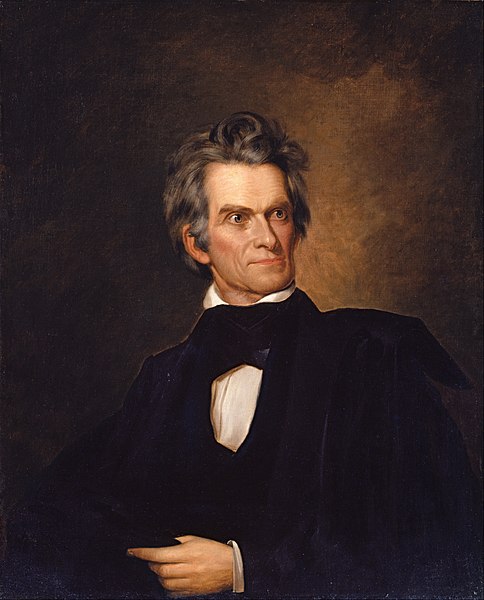
John C Calhoun - Tyler used his immense presidential patronage power to construct the National Democratic Party using the officeholders and political networks he had established the previous year.
- Tyler directed Secretary of State John C Calhoun to initiate discussions with Texas President Sam Houston for Texas annexation in the spring of 1844. To buttress annexation and keep Mexico away, Tyler boldly ordered the US Army to the Texas border in western Louisiana. He was a firm supporter of Texas annexation.
- Tyler was unmoved when the Whig-controlled Senate rejected his treaty by a vote of 16 to 35 in June 1844. He believed that annexation could now be accomplished through a joint resolution rather than a treaty, and he requested it from Congress. Jackson, a staunch annexationist, persuaded US politician James Polk to accept Tyler into the Democratic Party and ordered Democratic editors to stop attacking him.
- Tyler resigned from the contest in August, satisfied with these developments, and endorsed Polk for president. The Tyler administration saw Polk’s narrow victory over Clay in the November election as a mandate to complete the resolution. In his yearly message to Congress, Tyler said that ‘a controlling majority of the people and a large majority of the states have declared in favour of immediate annexation.’
POST-PRESIDENCY
- Tyler re-entered public life on the eve of the American Civil War as the presiding officer of the Washington Peace Conference, convened in February 1861 in Washington, DC, to prevent the conflict from escalating.
- Even as the Confederate Constitution was being drafted at the Montgomery conference, the conference sought a settlement to avoid civil war. Tyler opposed the Peace Conference’s final resolutions despite his leadership role. He believed free state delegates created them, would not safeguard the rights of enslavers in the territories, and would do little to restore the Union and bring back the lower South.
- Residents elected Tyler to the Virginia Secession Convention on the same day as the Peace Conference began. While the Peace Conference was still in session, he presided over the opening session on 13 February 1861.
Death
- Tyler’s health deteriorated throughout his life. As he grew older, he became increasingly prone to colds in the winter. On 12 January 1862, he vomited and fainted after complaining of chills and dizziness. Tyler died of a stroke at the age of 71.
- Because he adhered to the Confederate States of America, Tyler’s death was the only one in presidential history that was not formally recognised in Washington. He had intended a simple burial, but Confederate President Jefferson Davis orchestrated a spectacular, politically charged funeral, portraying Tyler as a hero to the fledgling republic.
Frequently Asked Questions
- What was John Tyler known for?
John Tyler is primarily known for being the tenth President of the United States from 1841 to 1845. He was notable for his role in annexing Texas, making it a state in 1845.
- How did John Tyler become President?
John Tyler became President of the United States in 1841 following the death of President William Henry Harrison. He was the first Vice President to assume the office due to the death of his predecessor.
- What political party did John Tyler belong to?
John Tyler was a member of the Democratic-Republican Party and later became affiliated with the Whig Party.

